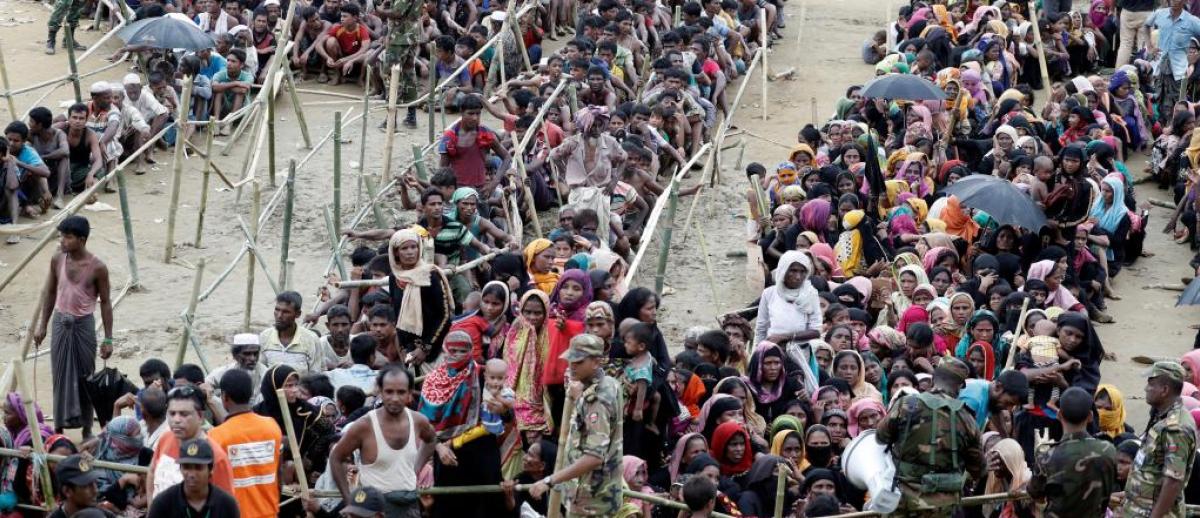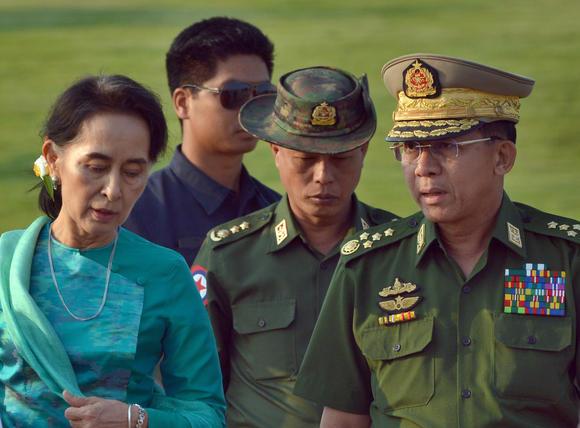View from the End: Myanmar, Genocide and the Rohingya
archive


View from the End: Myanmar, Genocide and the Rohingya
"I only want to go where I can be Rohingya"
(Zura Begum Balukali Camp, Bangladesh1)
I have just returned from a 9-day field trip to the vast Rohingya camp in southwest Bangladesh—what must now be the largest refugee camp in the world and growing daily. Since August 25th 2017, some 800,000 Rohingya have fled genocidal violence in Northern Rakhine State to an unknown future across the border in a country which doesn’t want them. The Myanmar government has claimed that the village “clearances” and state terror which forced the Rohingya from Myanmar were in response to an alleged attack by the Arakan Rohingya Salvation Army (ARSA) on police and army posts in Rakhine State. As well as apparently seeking out the perpetrators, the Myanmar state has used this allegation as the pretext to remove all traces of the Rohingya from Myanmar.
Along with my colleagues Thomas MacManus and Alicia de la Cour Venning—all of us members of the International State Crime Initiative—I conducted in depth interviews with 40 Rohingya men and women and spoke with over 35 others in the camp areas of Kutupalong, Balukali, Thanakali, and Nayapara, and in the Rohingya ward of Cox’s Bazar Sadar Hospital. Everyone we spoke with had fled the terrifying denouement of Myanmar’s 30-year genocide.
The Rohingya we met had been in the camps for up to six weeks. All those we spoke with had suffered the deepest of human of traumas—the slaughter of family, friends, and neighbors, village burnings, mass rapes, acts of unimaginable barbarity and the total destruction of their homes and homeland. They had travelled dangerous routes on their flight from genocidal terror, threatened by military battalions, border police, hostile armed Rakhine nationalists and state-planted land mines.
We listened to first hand accounts of men, women and children who shared horrifying accounts of babies and the elderly burnt alive in their homes, throats slit, bodies hacked to pieces and thrown on to burning piles. Rohingya villagers told of massacres in villages such as Chut Pyin and Tula Toli, but they also offered evidence that speaks loudly to the planned and carefully orchestrated nature of Myanmar’s genocidal end-game. For 10 months leading up to the killings and village “clearances,” Rohingya communities had been placed under a tight curfew which confined them to their houses between 6pm and 6am. The Rohingya of Northern Rakhine State are not strangers to restrictions on their freedom of movement. While members of the Rakhine and other ethnic groups could travel freely after the 2012 pogroms in Rakhine state’s capital Sittwe, travel for the Rohingya became tightly constrained. To move from village to village required permission from a Rakhine Village Administrator and travel between the major townships of Maungdaw, Buthidaung, and Rathedaung required the formal approval of both village and township Administrator.
We also learned of greater restrictions placed on all (and only) Rohingya in response to the alleged ARSA attacks of late August, the widespread arrests of young men, military-instigated village meetings designed to threaten and invoke fear among the Rohingya, and the extension of the curfew to include collective house arrest across the whole of Northern Rakhine State. Rohingya villagers reported no longer being allowed to tend their livestock, to buy and sell at the market, to fish in the rivers or gather wood from the forests. We heard stories of people dying of preventable diseases because they were unable to travel to a hospital or clinic, people growing hungry because they no longer had access to food, and of people growing ever more fearful of what was to come.
Since August 25th 2017, some 800,000 Rohingya have fled genocidal violence in Northern Rakhine State to an unknown future...
At the same time, village tract meetings were being called by either the military or the border police and those Rohingya elders who were present were ordered to ensure that the curfew was maintained and instructed to cooperate fully with the security forces in rooting out “bad people.” When elders protested that no terrorist sympathizers lived in their villages, they were threatened with death.
According to one unofficial Rohingya village administrator, the high ranking military commander Aung Min Thu told him and his fellow villagers: “We don’t want to hear anything from you. Just follow our orders. If you don’t, we’ll shoot—if we find anyone in the forest, at the market, at the river, out of the home, we will shoot.”
Evidence from Rohingya survivors, satellite imagery of burnt villages, and reports from NGOs such as Amnesty International and Human Rights Watch leave no doubt that the perpetrators were the Myanmar military, the Border Police Guards, local Rakhine extremists and the government of Aung San Suu Kyi. But denial and cover-ups are essential components of state crime.
On November 14th the Myanmar military’s ‘True News Information Team' released the findings of its own investigation into the conduct of its troops:
“…security forces did not commit shooting at innocent villagers and sexual violence and rape cases against women. They did not arrest, beat and kill the villagers. They did not totally destroy, rob and take property, gold and silverwares, vehicles and animals…”2
While Aung San Suu Kyi and the Myanmar military continue to lie and deny their involvement, the burnings, lootings, rapes and killings continue. And they will continue until the very last Myanmar Rohingya is no more in Rakhine state. That’s what genocide is—the intended destruction in whole or part of an ethnic, racial or national group. Destruction can be accomplished through a variety of means; for the Rohingya it has involved mass killings, the wholesale destruction of villages and communities, mass forced evictions, mass rapes, enforced starvation and systematic weakening. Those we interviewed described in graphic detail instances where soldiers forcibly separated men and women before slaughtering or ‘disappearing’ the men. We learned that teachers, village elders and religious leaders were targeted as part of an explicit strategy to attempt to destroy the cultural memory of the Rohingya. When we combine the evidence that has emerged with such brutal clarity from Northern Rakhine State with our earlier findings from Sittwe, the charge of genocide is undeniable.

Aung San Suu Kyi and Senior Gen. Min Aung Hlaing
While a state of unmitigated terror has rained down upon the Rohingya since August 25th of this year, the Rohingya have been the genocidal target of successive Myanmar regimes for many years. Now fewer than 300,000 Rohingya remain (half of them incarcerated in camps and ghettos in Sittwe from which they cannot leave).
Destruction can be accomplished through a variety of means; for the Rohingya it has involved mass killings, the wholesale destruction of villages and communities, mass forced evictions, mass rapes, enforced starvation and systematic weakening.
What has happened to the Rohingya has shocked the world. Yet the international community of states cannot claim ignorance. It has known about the persecution of the Rohingya for many years but has done nothing to alleviate their suffering, nor punish Myanmar’s perpetrators for their crimes of hate and violence. Indeed China, India, and Russia have aligned themselves with Myanmar’s brutal regime. This is a ‘never again moment’—a well-rehearsed refrain from the international community of states that far too often produces no resultant consequences for perpetrators.
In 2015 we published Countdown to Annihilation: Genocide in Myanmar,3 a detailed research report based on interviews with almost 200 people in and around Sittwe. We interviewed Rohingya in the vast detention camp complex into which the majority of Sittwe’s Rohingya were herded following state sponsored violence against them in 2012. We also interviewed Rohingya trapped in the city’s only ghetto, Aung Mingalar, and in the region’s ‘prison’ villages. Under mass incarceration and reliant on food aid, they have been denied all civil rights, access to livelihood, and adequate health care. The Rohingya were living ‘bare lives’ in fragmented depressed communities. Their ‘systematic weakening’ presaged the penultimate stage of the genocide process. Only annihilation and symbolic enactment remained, and in 2014 we had already witnessed examples of both.
Our report, then, offered a stark assessment that was ignored by governments around the world:
"This report concludes with an urgent warning to civil society in Myanmar, to international civil society, to the government of Myanmar and to international states. A genocidal process is underway in Myanmar and if it follows the path outlined in this report, it is yet to be completed. It can be stopped but not without confronting the fact that it is, indeed, a genocide."
It is now too late.
1. Interview with Zura Begum, originally from Rathedaung Township 31st October 2017.
She walked 14 days with her baby to the border.
2. https://m.facebook.com/story.php?story_fbid=1511217488999111&id=52650316...
3. Green, P, MacManus, T and de la Cour Venning, A. 2015 Countdown to Annihilation:



